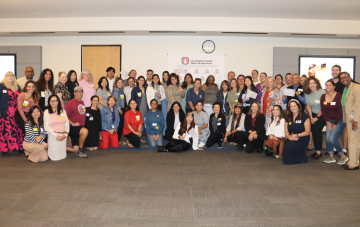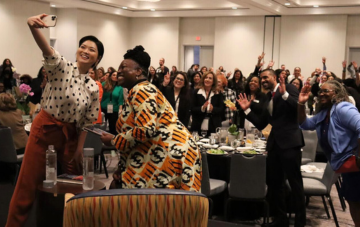Sexual Violence Prevention and Education
Wed Apr 19 00:00:00 PDT 2023
To combat and educate on sexual violence, LACOE has compiled resources to help educators and students across LA County end sexual violence.
Sexual assault and sexual violence are still prevalent in our society and impact our youth. In February 2023, the CDC released some startling data points related to teen girls. According to this report 1 in 5 teen girls experienced sexual violence in the past year—up 20% since 2017, when CDC started monitoring this measure. More than 1 in 10 had been forced to have sex—up 27% since 2019 and the first increase since CDC began monitoring this measure.
To combat and educate on sexual violence, LACOE has compiled resources to help educators and students across LA County end sexual violence.
What is sexual violence?
Any sexual activity that is forced or nonconsensual by means of psychological coercion or physical abuse.
Source: Peace Over Violence
Types of sexual violence include:
- Rape
- Forced sodomy
- Forced oral copulation
- Acts committed with foreign objects
- Sexual threats and intimidation
- Incest
- Sexual assault by intimate partners
- Child sexual abuse
- Human sexual trafficking
- Sexual harassment
- Street harassment and any other unwanted sexual activity
What is sexual assault?
The term sexual assault refers to sexual contact or behavior that occurs without explicit consent of the victim.
Source: RAINN.org
Some forms of sexual assault include:
- Attempted rape
- Fondling or unwanted sexual touching
- Forcing a victim to perform sexual acts, such as oral sex or penetrating the perpetrator’s body
- Penetration of the victim’s body, also known as rape
Denim Day
The Denim Day campaign in 1999 after an Italian Supreme Court decision overturned a rape conviction because they felt that because the teenage victim wore tight jeans, she must have helped the person who raped her remove her jeans, implying consent to sex. Wearing jeans became an international symbol of protest against the misinformation and attitudes about sexual assault.
As the longest-running sexual violence prevention and education campaign in history, Denim Day asks community members, including educators and students, to make a social statement by wearing jeans on this day. Denim Day is an activist movement that brings awareness to victim blaming and the need to change the narrative and misconceptions of sexual violence.
Denim Day Facts and Statistics
- In the US, over half of women and almost 1 in 3 men have experienced sexual violence involving physical contact during their lifetime.
- More than 4 in 5 female rape survivors reported that they were first raped before age 25 and almost half were first raped as a minor.
- Women and racial and ethnic minority groups experience a higher burden of sexual violence.
- 63% of sexual assaults are never reported to the police.
- 1 in 6 men experience abusive sexual experiences before the age of 18.
- Almost two-thirds of rapes are committed by someone the victim knows.
- 44% of sexual assault and rape victims are under the age of 18.
- Women who have been raped in the military have a higher rate of PTSD than men who’ve been in combat.
- Around the world, 1 in 3 women will be raped or beaten in her lifetime.
- Recent estimates put the lifetime cost of rape at $122,461 per survivor, including medical costs, lost productivity, criminal justice activities, and other costs.
Steps Schools Can Take
- Implement Comprehensive Sexual Violence Prevention Programs: Schools can develop comprehensive prevention programs that cover topics such as healthy relationships, consent, sexual harassment, and bystander intervention. These programs should be age-appropriate and incorporate evidence-based practices.
- Train Faculty and Staff: Faculty and staff should receive training on how to recognize and respond to sexual violence. They should also be educated on how to create a safe and inclusive learning environment.
- Provide Resources for Survivors: Schools should provide resources and support for survivors of sexual violence. This could include counseling services, medical services, and legal services.
- Foster a Culture of Consent: Schools can promote a culture of consent by teaching students about consent and healthy relationships. This can include workshops, guest speakers, and discussions.
- Encourage Reporting: Schools should encourage students to report sexual violence and have a clear reporting process. This should include a designated point person for reporting and investigation.
- Hold Perpetrators Accountable: Schools should hold perpetrators of sexual violence accountable for their actions. This could include disciplinary action, criminal charges, or referral to outside services.
- Evaluate and Improve Programs: Schools should regularly evaluate their sexual violence prevention programs to ensure they are effective and making a positive impact. Feedback from students, faculty, and staff should be taken into consideration to continuously improve the program.
Resources
Peace Over Violence Website: the official website of Peace Over Violence, an over 50-year-old nonprofit, multicultural, community based and volunteer centered organization dedicated to building healthy relationships, families and communities free from sexual, domestic and interpersonal violence. PeaceOverViolence.org
Denim Day Official Website: the official website of the Denim Day campaign, which provides information about the history of the campaign, resources for schools and communities, and ways to get involved. Website: https://www.denimdayinfo.org/
YouTube Video: Denim Day - Stand Against Sexual Violence
RAINN Website: RAINN (Rape, Abuse & Incest National Network) is the nation's largest anti-sexual violence organization. RAINN.org
National Sexual Violence Resource Center (NSVRC) Denim Day Resources: a section of the NSVRC website that provides resources and tools for participating in Denim Day, including social media graphics and posters. Website: https://www.nsvrc.org/
ValorUS is a national organization committed to advancing equity and ending sexual violence. Through leadership, prevention, and advocacy, they are fearlessly pursuing a world free from violence where the dignity of every person is valued and respected. https://www.valor.us/ ( Valor is formerly the California Coalition Against Sexual Assault (CALCASA)
The Network/La Red: a survivor-led, social justice organization that works to end partner abuse in lesbian, gay, bisexual, transgender, kink, polyamorous, and queer communities. Rooted in anti-oppression principles, our work aims to create a world where all people are free from oppression. http://www.tnlr.org/en/
American School Counselor Association (ASCA) Sexual Violence Resources: a section of the ASCA website that provides resources and tools for school counselors to address sexual violence and support survivors. Website: https://www.schoolcounselor.org/Magazines/July-August-2012/Sexual-Violence-Among-our-Students-The-School-Coun
Stop Sexual Assault in Schools: This organization proactively addresses the epidemic of traumatic sexual harassment impacting our nation’s students. Providing students, K-12 schools, and organizations with resources so that the right to an equal education is not compromised by sexual harassment, sexual assault, and gender discrimination: https://www.stopsexualassaultinschools.org/
Futures Without Violence: This organization is a health and social justice nonprofit with a simple mission: to heal those among us who are traumatized by violence today – and to create healthy families and communities free of violence tomorrow: https://www.futureswithoutviolence.org/
National Sexual Assault Hotline: (800) 656-HOPE (4673)





















